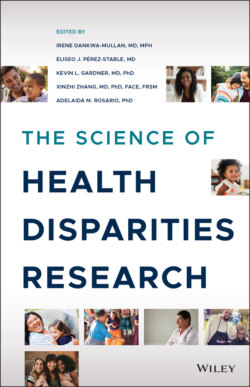Читать книгу The Science of Health Disparities Research - Группа авторов - Страница 65
References
Оглавление1 1 Marmot, M., Friel, S., Bell, R. et al. (2008). Closing the gap in a generation: health equity through action on the social determinants of health. The Lancet 372 (9650): 1661–1669.
2 2 Marmot, M. and Allen, J.J. (2014). Social Determinants of Health Equity. American Journal of Public Health 104 (Suppl4): S517–S519.
3 3 LaVeist, T.A. (2005). Conceptual issues in race/ethnicity and health. In: Minority Populations and Health, 15–29. San Francisco, CA: Jossey‐Bass.
4 4 Houghton Mifflin Harcourt Publishing Company (2017). American Heritage Dictionary of the English Language, 5e. Boston, MA: Houghton Mifflin Harcourt.
5 5 LaVeist‐Ramos, T.A., Galarraga, J., Thorpe, R.J. et al. (2012). Are black Hispanics black or Hispanic? Exploring disparities at the intersection of race and ethnicity. Journal of Epidemiology and Community Health 66 (7): e21.
6 6 National Center for Health Statistics (2016). Health, United States, 2015: With Special Feature on Racial and Ethnic Health Disparities. Hyattsville, MD: National Center for Health Statistics.
7 7 Gardner, J.W. and Sanborn, J.S. (1990). Years of potential life lost (YPLL) – what does it measure? Epidemiology 1 (4): 322–329.
8 8 Xu, J., Murphy, S.L., Kochanek, K.D., and Arias, E. (2016). Mortality in the United States, 2015. Hyattsville, MD: National Center for Health Statistics.
9 9 Brown, A.F., Ettner, S.L., Piette, J. et al. (2004). Socioeconomic position and health among persons with diabetes mellitus: a conceptual framework and review of the literature. Epidemiologic Reviews 26: 63–77.
10 10 Berkman, L.F., Kawachi, I., and Glymour, M.M. (2014). Social Epidemiology. Oxford: Oxford University Press.
11 11 Chen, E. and Miller, G.E. (2013). Socioeconomic status and health: mediating and moderating factors. Annual Review of Clinical Psychology 9: 723–749.
12 12 Krieger, N., Williams, D.R., and Moss, N.E. (1997). Measuring social class in US public health research. Annual Review of Public Health 18: 341–378.
13 13 Saez, E. and Zucman, G. (2014). Wealth Inequity in the United States since 1913: Evidence from Capitalized Income Tax Data. Cambridge, MA: National Bureau of Economic Research.
14 14 Kondo, N., Sembajwe, G., Kawachi, I. et al. (2009). Income inequality, mortality, and self rated health: meta‐analysis of multilevel studies. The BMJ 339: b4471.
15 15 Pickett, K.E. and Wilkinson, R.G. (2015). Income inequality and health: a causal review. Social Science & Medicine 128: 316–326.
16 16 Diez Roux, A.V. and Mair, C. (2010). Neighborhoods and health. Annals of the New York Academy of Sciences 1186: 125–145.
17 17 Cuéllar, I., Arnold, B., and Maldonado, R. (1995). Acculturation rating‐scale for Mexican Americans‐II: a revision of the original ARSMA scale. Hispanic Journal of Behavioral Sciences 17 (3): 275–304.
18 18 Marín, G., Sabogal, F., Marín, B.V. et al. (1987). Development of a short acculturation scale for Hispanics. Hispanic Journal of Behavioral Sciences 9 (2): 183–205.
19 19 Suinn, R.M., Rickard‐Figueroa, K., Lew, S., and Vigil, P. (1987). The Suinn‐Lew Asian self‐identity acculturation scale: an initial report. Educational and Psychological Measurement 47 (2): 401–407.
20 20 Ryder, A.G., Alden, L.E., and Paulhus, D.L. (2000). Is acculturation unidimensional or bidimensional? A head‐to‐head comparison in the prediction of personality, self‐identity, and adjustment. Journal of Personality and Social Psychology 79 (1): 49–65.
21 21 Lillie‐Blanton, M. and Laveist, T. (1996). Race/ethnicity, the social environment, and health. Social Science & Medicine 43 (1): 83–91.
22 22 Williams, D.R. (1999). Race, socioeconomic status, and health. The added effects of racism and discrimination. Annals of the New York Academy of Sciences 896: 173–188.
23 23 Siegler, V. (2014). Measuring National Well‐being: Measuring Social Capital Consultation Response. London: Office for National Statistics.
24 24 Sampson, R.J., Raudenbush, S.W., and Earls, F. (1997). Neighborhoods and violent crime: a multilevel study of collective efficacy. Science 277 (5328): 918–924.
25 25 National Research Council (2013). US Health in International Perspective: Shorter Lives, Poorer Health. Washington, DC: National Academies Press.
26 26 LaVeist, T., Pollack, K., Thorpe, R. et al. (2011). Place, not race: disparities dissipate in southwest Baltimore when blacks and whites live under similar conditions. Health Affairs 30 (10): 1880–1887.
27 27 LaVeist, T., Thorpe, R., Bowen‐Reid, T. et al. (2008). Exploring health disparities in integrated communities: overview of the EHDIC study. Journal of Urban Health 85 (1): 11–21.
28 28 Kershaw, K.N., Giacinto, R.E., Gonzalez, F. et al. (2016). Relationships of nativity and length of residence in the U.S. with favorable cardiovascular health among Hispanics/Latinos: The Hispanic Community Health Study/Study of Latinos (HCHS/SOL). Preventive Medicine 89: 84–89.
29 29 Dubowitz, T., Ghosh‐Dastidar, M., Cohen, D.A. et al. (2015). Diet and perceptions change with supermarket introduction in a food desert, but not because of supermarket use. Health Affairs 34 (11): 1858–1868.
30 30 Richardson, A.S., Troxel, W.M., Ghosh‐Dastidar, M.B. et al. (2017). One size doesn't fit all: cross‐sectional associations between neighborhood walkability, crime and physical activity depends on age and sex of residents. BMC Public Health 17 (1): 97.
31 31 Carson, V., Ridgers, N.D., Joward, B.J. et al. (2013). Light‐intensity physical activity and cardiometabolic biomarkers in US adolescents. PLoS One 8 (8): e71417.
32 32 Andersen, L.B., Harro, M., Sardinha, L.B. et al. (2006). Physical activity and clustered cardiovascular risk in children: a cross‐sectional study (The European Youth Heart Study). Lancet 368 (9532): 299–304.
33 33 Gary‐Webb, T.L., Suglia, S.F., and Tehranifar, P. (2013). Social epidemiology of diabetes and associated conditions. Current Diabetes Reports 13 (6): 850–859.
